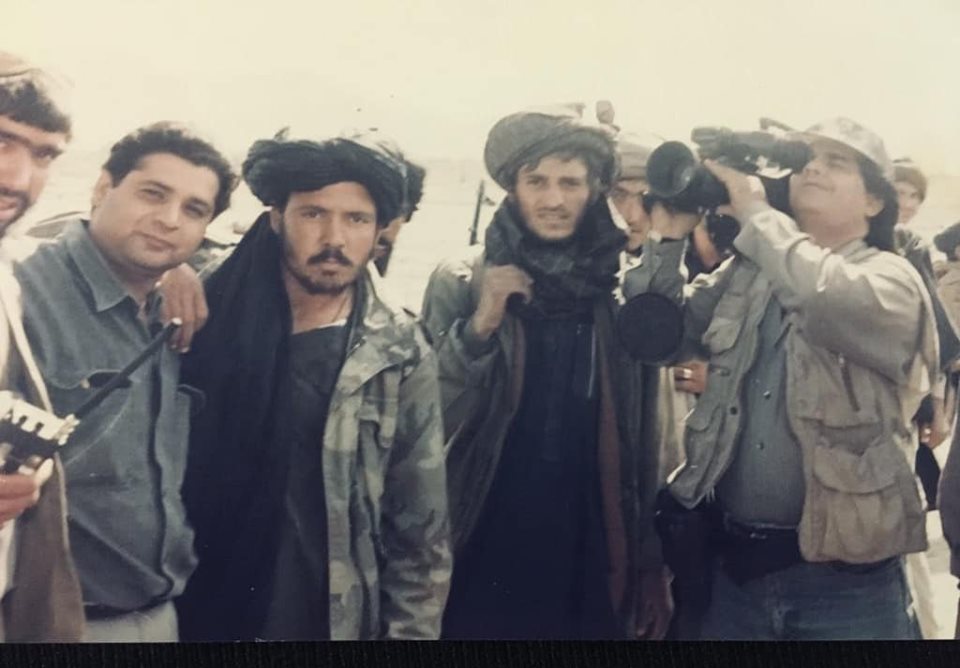By Agha Iqrar Haroon

He is also Chief Editor of DND News Agency. He covered Afghan War during 1995-97 and then during 2001-2004 as Conflict Reporter
What would be the policy of the US President for the Afghan conflict? is the most-covered question of international media nowadays.
A recently published 1,680-worded article that is coauthored by the top five foreign affairs experts of the United States who served in Afghanistan suggested President Biden not leave Afghanistan abruptly. They suggested Oval Office keep engage in an unwinnable war.
The article titled “The way forward in Afghanistan: How Biden can achieve sustainable peace and US security” published in New Atlanticist coauthored by James B. Cunningham, Hugo Llorens, Ronald E. Neumann, Richard Olson, and Earl Anthony Wayne says that Joe Biden’s team should make it clear that peace does not mean simply handing the country to the Taliban and it requires foreclosing a Taliban military victory.
The greatest dilemma of Afghanistan is that the United States and NATO allies consider Afghanistan as a “War Zone” instead of a “Conflict Zone”. Conflicts are resolved or addressed while Wars are either lost or won.
Writers say that Biden team must do all this (peace process) while recognizing successful negotiations, ones that will maintain constitutional government and human—including women’s—rights, will likely take a substantial period of time.
Meanwhile, Steve Coll who is the Dean of the Graduate School of Journalism at Columbia University and author of “Directorate S: The C.I.A. and America’s Secret Wars in Afghanistan and Pakistan” in his article published in The New Yorker says that when Biden will confront early decisions that will define the contours of the war’s next chapter and determine the legacy of the American-led invasion, an enterprise that, based on official data, has cost the nation more than eight hundred billion dollars so far, and for which more than twenty-four hundred Americans have given their lives.
Steve Coll believes that President Biden has long experience with Pakistan, and he knows the country well enough to have acquired a realistic skepticism of its military commanders and influence in Afghanistan. He indicates that President Biden well understands the Afghan issue and his (Biden’s) dilemma is that he has no easy way forward and the problem of the Afghan war hasn’t gotten any easier since Biden left it four years ago (as Vice-President), now, as then, there are no good or easy options—only less bad ones.
The greatest dilemma of Afghanistan is that the United States and NATO allies consider Afghanistan as a “War Zone” instead of a “Conflict Zone”. Conflicts are resolved or addressed while Wars are either lost or won. This mindset of Americans keeps Afghanistan boiling and fueling with human blood for the last four decades. Americans are not ready to “lost” war, therefore, they will keep clutching the situation instead of losing the position for making some space for other options outside the descriptions of “winning” or “losing”.
Being a Reporter who covered Afghan War during 1995-97 and then in 2001-2006, I believe that no war has ever won or lost in Afghanistan. War is continuing in Afghanistan for ages, it just changes the shapes and colours. I reported the fall of Mujahideen and the rise of the Taliban and then I saw the withdrawal of the Taliban from Kabul but this dramatic withdrawal of the Taliban was also the birth of another unwinnable war that continues today.
If we look into events of Afghanistan from Operation Cyclone to Operation Enduring Freedom— this is nothing but a continuity of war with different dimensions and colours.
Political scientists believe that nations who do not know the currents and undercurrents of the “Myth of Independence” usually crumble when they work as the second fiddle of any superpower—so it happens to Pakistan—No regrets.
Let’s have a look into the history of over four-decade-long Afghan War to determine that whether the United States is ready to leave or would enhance its presence in Kabul.
Let me take you in past:
“Afghanistan is flourishing, girls are going to schools with a smile on their faces, the economy is stable and tolerance level in society is normal and foreigners and non-Muslims are living in Kabul without any fears”. Do not be excited I am not talking about today’s Afghanistan—This is Afghanistan of the late 60s and early 70s. Yes, you could see American schools working in Kabul, foreigners shopping in bazaars (markets) of Kabul without Islamic hijab or canopy-like Burkas. These are bygone days—days before the Russo-Afghan war and the Islamisation of society injected by the United States to bog down USSR in Kabul. Yes, Russia was bogged down by US-sponsored Mujahideen (worriers of Allah) and then Mujahideen were bogged down by the Taliban, and then Taliban were bogged down by US-led ISAF forces.
But there is a difference—when USSR was bogged down, it left Afghanistan—When Mujahideen were bogged down—they joined Taliban—When Taliban were bogged down—-They stayed in Afghanistan and fought back and still fighting and negotiating peace with the United States at the same time.
Pakistan the promising friend of United suffered the greatest losses—its social fabrics broke down. Its economy and society had crumbled and it was facing more dangers than Afghanistan faces today. Pakistan had to fight a war against self-injected radicalization that cost over 80,000 men, women, and children, army officers, and soldiers. Thank God Pakistan won this war and radicalization was snubbed by the State. Political scientists believe that nations who do not know the currents and undercurrents of the myth of Independence usually crumble when they work as the second fiddle of any superpower—so it happens to Pakistan—No regrets.
The withdrawal of Soviet combatant forces from Afghanistan began on 15 May 1988 and successfully executed on 15 February 1989 under the leadership of Colonel-General Boris Gromov who also was the last Soviet general officer to walk from Afghanistan back into Soviet territory through the Afghan-Uzbek Bridge.
Under the Geneva Accords on 15 April 1988, Afghanistan and Pakistan signed three instruments-on principles of mutual relations, in particular non-interference and non-intervention, on the voluntary return of Afghan refugees, and on interrelationships for the settlement, which provided for a phased withdrawal of foreign troops to begin on 15 May. The United States and the USSR also signed a declaration on international guarantees, stating they would both refrain from any form of interference and intervention.
The 1989 to 1992 phase of the Afghan Civil War began after the Soviet Union withdrew from Afghanistan, leaving the Afghan communist government to fend for itself against the Mujahideen. After several years of fighting, the government fell in 1992.
According to some available documents, by the spring of 1989, the Afghan government showed no signs of falling apart, and the American and Pakistan supporters of some of the mujahideen decided to hasten its demise. An operation was planned, under the impulsion of U.S. ambassador to Pakistan Robert B. Oakley to capture Jalalabad. Pakistan intended to install a new government under Gulbuddin Hekmatyar with its provisional capital based in Jalalabad. The Pakistan-backed Afghan Interim Government included Gulbuddin Hekmatyar as Prime Minister and Abdul Rasul Sayyaf as Foreign Minister.
I was in Kabul reporting for ETN News when the Taliban seized the Afghan capital on September 27, 1996, and established the Islamic Emirate of Afghanistan
In April 1992, Kabul came under a heavy bombardment campaign which marked the beginning of a new phase in the war. Civil war continued for more than four years at full speed but then the Taliban emerged and Eastern Afghanistan came under their control and the only one left to fight with them was Ahmad Shah Mahsud.

For this writer, the last 40 years of Afghanistan looks like a historical war film and I name it “From Operation Cyclone to Operation Enduring Freedom”: A Told Story of Destruction”.
I was in Kabul reporting for ETN News when the Taliban seized the Afghan capital on September 27, 1996, and established the Islamic Emirate of Afghanistan. The then Defense Minister of the Islamic State of Afghanistan, Ahmad Shah Massoud, created the United Front (Northern Alliance) in opposition to the Taliban. The United Front included all Afghan ethnicities: Tajiks, Uzbeks, Hazaras, Turkmens, some Pashtuns, and others while Middle Eastern Al Qaeda supported Taliban with regiments of imported fighters from Arab countries and Central Asia.
Now in February 2021, after 20 years of Operation Enduring Freedom, the war is still on in Afghanistan.
In the late period of the war, an estimated 45,000 force fighting on the side of the Taliban included only 14,000 Afghan Taliban rest was foreigners. The civil war between South and North Afghanistan continued and the US attacked Afghanistan in response to the terror attacks of 11 September. The early combat operations that took place on October 7, 2001, included a mix of strikes from land-based B-1 Lancer, B-2 Spirit and B-52 Stratofortress bombers, carrier-based F-14 Tomcat and F/A-18 Hornet fighters, and Tomahawk cruise missiles launched from both U.S. and British ships and submarines signaled the start of Operation Enduring Freedom – Afghanistan (OEF-A).
Long history of the war in Afghanistan started in the late 80s indicates that the United States would not leave Afghanistan sooner rather there is a chance for increased presence US military in months to come.
The initial military objectives of OEF-A, as articulated by former President George W. Bush in his 20 September address to a Joint Session of Congress and his 7 October address to the countrymen, included the destruction of terrorist training camps and infrastructure within Afghanistan, the capture of al-Qaeda leaders, and the cessation of terrorist activities in Afghanistan.
Now in February 2021, after 20 years of Operation Enduring Freedom, the war is still on in Afghanistan.
For this writer, the last 40 years of Afghanistan looks like a historical war film and I name it “From Operation Cyclone to Operation Enduring Freedom”: A Told Story of Destruction”. This film has all blends of a blockbuster movie including Suspense–Horror–Intrigues—Action and Comedy. Today’s Comedian is Afghan President Ashraf Ghani who believes he controls Afghanistan.
This long history of the war in Afghanistan started in the late 80s indicates that the United States would not leave Afghanistan sooner rather there is a chance for increased presence US military in months to come. We understand former President Trump was a man of business and achievement and US totally refrained from involving in any war but President Biden is an expert in politics and US politics evolves around regime changes, wars, and chaos.
To my understanding, the destruction of Afghanistan can only be ceased if (ever) the US considers Afghanistan as a Conflict Zone rather than a War Zone, and then it can try to address and mitigate reasons for Conflict and can move forward towards Conflict Resolution.
Remembering some points from my frank and candid discussion with former National Security Advisor (NSA) of Pakistan Lt Gen (retd) Nasser Janjua in his office and his understanding and vision, I believe his viewpoint can be useful to address the Afghan issue. He said:
“Unending Afghan conflict may not be won with vengeance or mere power but through seeking closure of conflict instead of winning it. Sometimes prolonged use of force gets diminishing returns. Closure of conflict can, however, help to end the suffering of Afghanistan and its poor people who have seen nothing else but a war for decades.
Stakeholders of the Afghan war are taking time to understand that Afghan conflict needs its closure which is easier to achieve option rather than winning the conflict”.
Will the US learn from the history of the Afghan War? Only time will answer this question.
Disclaimer:
The views and opinions expressed in this article/Opinion/Comment are those of the author and do not necessarily reflect the official policy or position of the Dispatch News Desk (DND). Assumptions made within the analysis are not reflective of the position of Dispatch News Desk.
